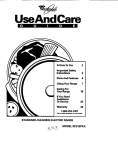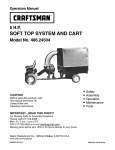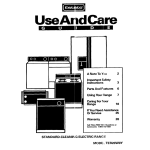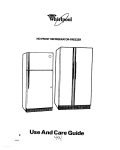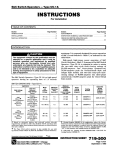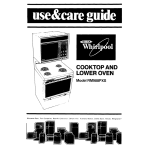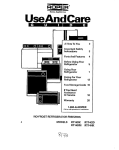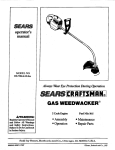Download -. wh H 01` UseAndCare
Transcript
-.wh 01’ H lfwroMua*HoAM~UseAndCare Table of Contents (complete) ....... .. ....... . 2 A Note to You ... .. ......... ... 3 Range Safety .................. 4 Getting to Know Your Range ...... .......... .... 7 Uslng Your Range ......... 8 Caring for Your Range ... .... ............. ........ 20 Troubleshooting .......... 28 Requesting Assistance or Service . ........... ......... 30 Index ...... .......... ........ ... .. 31 Warranty .... ............ ....... 32 I -800-253-I 301 Cd us with qudions of comments. CONTINUOUS-CLEANING ELECTRIC RANGE PART NO. 3189087 Rev. A MODEL RF330PXD qi6 Table of Contents A Note to You ............................................ 3 Range Safety ............................................ 4 Getttng to Know Your Range ................... 7 Udng Your Range .................................... 8 Using the surface units ......................... 8 Positiiing rack and parts ................ 10 For best air cifcutation ........................ 10 s43ttingthe clock ................................ 11 Usiq the Minute Tmar ...................... 12 Baking/roasting .................................. 13 Adjusting the oven temperature cmtrd ............................................... 14 Broiling .............................................. 15 BroiGngtips ........................................ 17 Energy saving tips ............................. 17 The ova-~vent .................................... 18 2 The storage drawer ............................ 18 The anti-tip bracket ............................ 19 optiil door panel pet ..................... 19 Caring for Your Range ........................... 20 Surface units and reflector bowls ........ 20 L&up cooktop ................................... 22 Removing the oven door .................... 22 The continuouscleaning oven ........... 23 Cleaning chart ................................... 25 The oven light .................................... 27 Tmublesbootlng ..................................... 28 Requesting Aaaistance or Servke ........ 30 ....................................................... 31 IlldeX Warranty ................................................. 32 A Note to You Thank you for buying a Whirlpool0 appliance. Because your life is getting busier and more complicated, Whiripcd ranges are easy to use, save time, and help you manage your home better. To ensure that you enjoy years of troubiefree operation, we developed this Use and Care Guide. it is full of valuable information about how to operate and maintain your appliance properly and safely. Please read it carefuiiy. Aiso, please axnpiete and mail in the Ownership Registration Card provided with your appliance. The cad helps us notify you about any new information on your appliance. Please record your model’s information. Whenever you call to request service for your appliance, you need to know your compiete model number and serial number. You can fii this information on the model and serial number plate (see diagram on page 7 for bcation of plate). Pieese also record the purchase date of your appliance and your ;leaier’s name, address, and telephone number. Keep this book end the sales slip together I Model Number Serial Number Purchase Date Dealer Name Dealer Address Dealer Phone in l safe place Our Consumer Assistance Center number is toll-free 24 hours a day. for future I-800-253-1 reference. 301 1 3 Range Safety Your safety is important to us. This guide contains safety statements under warning symbols. Please pay special attention to these symbols and follow any instructions given. Here is a brief explanation of the use of the syrnbd. IMPORTANT SAFETY F This symbd alerts you to such dangers as personal injury, bums, fire, and eiectriii shock. INSTRUCTIONS To reduce the risk of fire, electrical shock, injury to persons, or damage when using the range, follow basic precautions, including the following: General *Read all instructions before using the range. 4nstall or locate the range only in accordance with the provided Installation Instructions. The range must be installed by a qualified installer. The range must be properly connected to electrical supply and grounded. *WARNING: To reduce the risk of tipping of the appliance, the appliance must be secured by a properly installed anti-tip bracket. To check if the bracket is installed properly, see “The anti-tip bracket” on page 19. @CAUTION: Do not store things children might want above the range. Children could be burned or injured while climbing on it. .Do not leave children alone or unattended in area where the range is in use. They should never be allowed to sit or stand on any part of the range. They could be burned or injured. @Donot operate the range if it is damaged or not working properly. @Donot use the range for warming or heating the room. Persons could be burned or injured, or a fire could start. l use the range only for its intended use as described in this manual. @Donot touch surface units, areas near units, heating elements, or interior surfaces of oven. Surface units and heating elements may be hot even though they are dark in color. Areas near surface units and interior surfaces of an oven become hot enough to cause burns. During and after use, do not touch or let clothing or other flammable materials contact surface units, areas near units, heating elements, or interior surfaces of oven until they have had sufficient time to cool. Other surfaces of the range, such as the oven vent opening, the surface near the vent opening, the cooktop, and the oven door and window, could also become hot enough to cause burns. *Do not wear loose or hanging garments when using the range. They could ignite if they touch a hot surface unit and you could be burned. @Useonly dry pot holders. Moist or damp pot holders on hot surfaces could result in burns from steam. Do not let pot holder touch hot heating elements. Do not use a towel or bulky cloth for a pot holder. It could catch on fire. l Keep range vents unobstructed. .Do not heat unopened containers. They could explode. The hot contents could cause burns and container particles could cause injury. @Useonly utensils approved for oven use. Follow utensil manufacturer’s instructions, especially when using glass or plastic utensils. @Donot store flammable materials on or near the range. The fumes could create an explosion and/or fire hazard. When using the cooktop l Make sure the reflector bowls are in place during cooking. Cooking without reflector bowls could subject the wiring and components underneath them to damage. ADO not line reflector bowls with aluminum foil or other liners. Improper installation of these liners could result in a risk of electric shock or fire. @Selecta pan with a flat bottom that is about the same size as the surface unit. If pan is smaller than the surface unit, some of the heating element will be exposed and could result in the igniting of clothing or pot holders. Correct pan size also improves cooking efficiency. *Check to be sure glass cooking utensils are safe for use on the range. Only certain types of glass, glass-ceramic, ceramic, earthenware, or other glazed utensils are suitable for cooktops without breaking due to the sudden change in temperature. *Never leave surface units unattended at high heat settings. A boilover could result and cause smoking and greasy spillovers that could ignite. @Turnpan handles inward, but not over other surface units. This will help reduce the chance of burns, igniting of flammable materials, and spills due to bumping of the pan. continued on next page 5 When using the oven Care and cleaning aAlways position oven rack(s) in desired location while oven is cool. If a rack must be removed while oven is hot, do not let pot holder contact hot heating eiement in oven. @Usecare when opening oven door. Let hot air or steam escape before removing or replacing food. @Donot soak removable heating elements in water. The element will be damaged and shock or fire could result. Grease @Donot use oven cleaners. No commercial oven cleaner or oven liner protective coating of any kind should be used in or around any part of the oven. *Do not clean door heat seal. It is essential for a good seal. Care should be taken not to rub, damage, or move the seal. Clean only parts recommended in this Use and Care Guide. *Do not repair or replace any part of the range unless specifically recommended in this manual. All other servicing should be referred to a qualified technician. *Disconnect the electrical supply before servicing the range. *Grease is flammable. Do not allow grease to collect around cooktop or in vents. Wipe spillovers immediately. &i& m *Do not use water on grease fires. Never pick up a flaming pan. Smother flaming pan on range by coveriig with a well-fitted lid, cookie sheet, or flat tray. Flaming grease outside of pan can be extinguished with baking soda or, if available, a multipurpose dry chemical or foam-type extinguisher. - SAVE THESE INSTRUCTIONS - Getting Range to Know Your Thii section contains captioned illustrations of your range. Use them to become familiar with the bcation and appearance of al4 parts and features. To help you find information on specific parts and features quickly, page references are inciuded. Plug-k, 8UlfaW unit wlth ~pbco reflector bowl - Automatic oven light switch (P. 27) A I’ /A Model and aerial Broil element (P. 16) / Bake element Anti-tip floor on alternate wall- Foil liner see page 19) Removable storage drawer (p-18) Control panel Left front control knob @P-8.25) I L&rear control knob (PP. 8.25) I I Surface unit marker (P- 8) I Surface unit indiir light (p. 8) Oven temperature control knob (pp. 13, 15, 16) oval selector WI1 3, 15) 1 I Clock/Minute Timer (pp. 11-12) I Oven heating indicator light (PP. 13,15) -I Manual oven light switch @; 27) l Right rear Right front control knob control knob (PP. 425) (PP. ~~25) 7 Using Your Range To obtain the best cooking resufts possible, you must operate your range properly. This section gives you important information for efficient and safe use of your range. Using the surface units Fire Hazard Be sure ail control knobs are turned to OFF and all indicator lights are OFF whenyouarenotcooking. Af~ecouldstartorsomeonecoukfbe burned if a surface unit is accidentally IefI ON. Push In control knobs before turning them to a setting. You can set them any where between HI and OFF. Surface unit markers Cookware l ThesoliddotinthesuIfaceunllmarker l Until you get used to the settings, use ths following as a guide. For best results, start amking at the high setting; then tum the control knob down to continue ccoking. SElllNG HI RECOMMENDED USE l To start foods cooking. l To bring liquids to a boil. l Toholdarapidboil. .Tofrychickenorparr cakes l For gravy, pudding, and icing. To cook large amounts l Tokeepfocdcooking l ofvegetabiis. l l 8 tips Select a pan that is about the same size as the surface unit. NOTE: For best results and greater energy efficiency, use only flat-bottomed cookware that makes good contact with the surface units. Cwkware with rounded, warped, ribbed (such as some porcelain enamelware), or dented bottoms could cause severe overheating, which damages the cookware and/or surface unit. You can, however, use the newer cookware available with slightly indented bottoms or very small expansion channels. This cookware is specially designed to provide the good contact needed for best cooking results. Also, woks, canners, and teakettles with flat bottoms suitable for use on your cooktop are now available in most stores that sell housewares. The pan shoukf have straight sides and a tight-ftiing lid. Choose medium to heavy gauge (thickness) pans that are fairly lightweight. The pan material (metal or gfass) affects how fast heat transfers from the surface l unit through the pan material and how evenfy heat spreads over the pan bottom. ;i pans that provide the best cooking . Home results. Use the largest surface unft for best results. Also, use a canner/pan which can be centered over the surface unit and which does not extend mofe than one inch outside surface unit area. Large diameter cannerslpans, if not properly centered, trap heat and can cause damage to the COOkW. l NOTES: l if a surface unlt stays red for a long time, the bottom of the pan is not flat enough or is too small for the surface unit. Prolonged usage at incorrect utensils coukf result in damage to the surface unit, uxktop, wiring, and sumxmding areas. To prevent damage, use corred utensils, start cooking on HI, and turn control down to continue C-WI. Do not leave an empty utensil, or one which has boiled dry, on a hot surface unit. The utensil could overheat and could damage the utensil or surface unit. information To protect your range: l Use fiat-bottomed canners/pans for best .Handbsehoukfbemedeofsturdy, heat-resistant material and be securely attached to the pan. l canning l l l l l Do not place csnner on two surface units at the same time. Too much heat will build up and will damage the cooktop. Start with hot water. Thic reduces the time the control is set on high. Reduce heat setting to lowest position needed to keep water boiling. Keep reflector bowls clean for best heat reflection. To prolong the life of the elements: - Prepare small batches at a time. - Do not use elements for canning all day. Refer to your canner manual for specific instnrctions. Optional canning kit The large diameter of most water-bath or pressure canners combined with high heat settingsforbngperiodsoftimecanshorten the life of regular surface units and cause damage to the ccxMop. If you plan to use the oooktop for canning, we recommend the installation of a Canning Ki. Order the kit (Part No. 242905) from your Whirlpool dealer or authorized Whirlpool service company. 9 Positioning racks and pans For baking/roasting wlth one rack, place theracksothetopofthefoodwillbe centered in the oven. Rack placement for spdfk foods: RACK POSITION Lowest level or FOOD Frozen pies, large roasts, turkeys, 2nd level from bottom 2nd level from ~onl angel food cakes Bundt cakes, most cpkp&Yt 9 meats ’ cookies, biscuits, muffii, cakes, nonfrozen pies When baking on two racks, arrange racks on bottom and third level from bottom. To change rack position, lift rack at front and pull out. NOTE: For recommended rack placement when broiling, see “Broiling rack position chart= on page 16. Personal Injury Hazard Always position oven rack(s) in desired bcatbn before turning oven on. Be sure the rack(s) is level. l If rack(s) must be moved while oven ishot,usepotholdersorovenmitts to protect hands. Failure to follow the above precautions could result in personal injury. l 2nd or 3rd level from bottom For best air circulation Usa the following as a gukle to determine where to place the pans: One pan Place in the center of the oven rack. Two pans Place in opposite corners of the oven rack. Hot air must circulate around the pans in the oven for even heat to reach all parts of the oven. This resutts in better baking. l Ptacathepanssothatoneisnotdirectly over the other. l For best results, allow 1’5%to 2 inches (4-5 cm) of space around each pan and between pans and oven walls. There must beaminimumspaceofl inch(3cm). l Usaonlyonecookiesheetintheovenat one time. 10 Three or four pana Place in opposite comers on each oven rack. Stagger pans so no pan is directly over another. Setting the clock WhenyoufKstplugintherange,orifyour els&i&y was off for a while, the display will show %6:W, then change to “-:-“. SET and CLOCK will show on the display. 1. Press the Clock Set Button. 2. Press the “up” or “down” pad to set time of day. Eachtime you pressthe ‘up” or “down” pad, the displayed time will increase or decrease by one minute. If you hold down the ?@ or “down” pad, the displayed time will incrsaseldecrsass in ten-minute amounts. 11 Using the Minute Timer The Minute Xnwr does not start or stop the oven. it works like a kitchen timer. Set it in minutes up to 24 hours. 2. Press the “up” or “down” pad to set de&red time. Each time you press the ‘up” or ‘down” pad, the displayed time will increase or decrease by one minute. If you hold down the “L# or ‘down” pad, the displayed time will increase/decrease In ten-minute amounts. 3. To cancel the Minute Timer after countdown Is over, press the Clock Set Button. YouwiUheartwotonesevery1Oseconds until you cancel the Minute Tier. NOTE: To cancel the Minute Tiier during a countdown, press the Tiir OnOff Button twice. The display will show ‘:OO” and SET TIMER. Then the display will return to the time of day. 12 (display mhows time of day) Baking/roasting 1. Position racks. For more infomdon, see ‘Positioning racks and pans” on page 10. 2. Set Oven Selector to BAKE and Oven Temperature Control to baklnghoasting temperature you want The OVEN HEATING Indicator Light will come on. The oven is preheated when the OVEN HEATING Indicator Light fKst goes off. NOTE: Do not preheat oven when roasting or cooking items such as casseroles. 3. Put food in oven. During baki@oasting, turn on and off to keep ture at the setting. The lndiitor Light will turn elements. the elements will the oven ternperaOVEN HEATING on and off with the NOTE: The top element helps heat during baklngkoastlng, but does not turn red. 4. After cooklng, turn off oven. I Turn both the Oven Selector and the Oven Temperature Control Knob to OFF. The OVEN HEATING lndiitor Light will go off. 13 Adjusting the oven temperature Although your new oven is properly adjusted to provide accurate temperatures, it may cook faster or dower than your old oven. If, after using the oven for a period of time, you are not satisfii with the baking/ roasting results, you can change the tern peraWe calibration by following these steps: control ,Tooth Locking lower Notches 2. Loosen the locking screws inside the conkoi knob. Note the position of the IlOtClWS. 1. Make sure the Oven Temperature Control Knob is tumed to the ofl position. Pull knob stmigM off and flip it over. 3. To lower the temperature, hold kncb handle fwmly and move the tooth a notch counterclockwise. Each notch equals about 5°F (2.5%). 4. To raise the temperature, hold kncb handle fKmiy and move the tooth a notch clockwii. Each notch equals about 5°F (2.5%). 5. Tighten the locking screws and replace the contrd knob. NOTE: DO NOT measure oven temperature with a thermometer. Opening the oven door will lower the oven temperature and give you an inaccurate reading. Also, the therrnometer temperature reading will change as your oven cycles. 14 Broiling NOTES: l Donotprebatwhenbroiling. l The Oven Selector must be on BROIL for brolllng temperatures. l Leavethedoorpartlyopenwhenever usingtheoventobroil.msalbwsthe oven to maintall ploper temperatures. 1. Position rack Position rack sc that the surface of the fccdisatleast3inches(7cm)away from the broil element. Bee ‘Broiling reck positii chart” on page 16. 2. Put food on broiler pan and place in center of oven rack 3. Position door. Close the door to the Broil Stop position (open aboul4 inches [lo cm]). The door will stay open by itself. 4. Set Oven Selector and Oven TemPerature Controi Knob to BROiL. The OVEN HEATING lndiitor comeon. Light will 5. When broiling is done, turn off oven. Turn both the Oven Selectcr and the Oven Temperature Ccntrd Knob to OFF. The OVEN HEATING lndiitor Light will go off. 15 To broil l at a lower temperature: If food is cooking too fast, turn the Oven Temperature Contrd Knob counterclockwise until the OVEN HEATING lndiitor Light goes off. l If you want food to broil slower from the start, set the Oven Temperature Control Knob between 170°F and 325°F (77% and 163%). These temperature settings albw the lxoil heating element to cycle and to sbw cooking. The bwer the tenperatum, the slower the cooking. l Fish and chkkan are some foods that may code better if you use bwer broiling temperatures. Broiling rack position chart RACK POSITiON TYPE OF FOOD/ FROM BOTTOM DONENESS 4 Hamburger patties and thin steaks, H’ thick or 3 Quickly searing food, rare and medium steaks, medium patties, ham slices, fiih steaks, frankfurters 2 Welldone steaks and patties, lamb chops, split chicken, pork steaks and chops, wholefish 1 16 Not used for broiling Broiling l l tips Use the broiler pan and grid for broiling. They are desiined to drain excess liquid and grease away from the cooking surface to help prevent spatter, smoke, or fire. After broiling, remove the broiler pan Fire Hazard Place food about 3’ or more from the broil element. l To ensure adequate grease drainage, do nol use cmkii sheets or similar pans for broiling. Also, covering the broiler grid with foil is not recommended. lf foil is used, cut slits in foil to line up with all openings in broiler grid. Grease can then drain away and cool in pan. Failure to fdbw the above could result in fire, burns, or other personal injury. l from the oven when you remove the food. Drippii will bake on the pan if you leave it in the heated oven. Energy saving tips Although the energy used for cooking is usually a very small percentage of the total energy ussd in the home, axking energy can be used efficiently. Here are some tips to help you save energy when using your cooking product: l Use pans with flat bottoms, straighi sides, and tight-fitting lids. l Match the pan to the surface unit size. l Cook with a minimum of liquid or fat to help shorten cooking time. l Preheat pans only when recommended and for the shorted time possible. l Start food on higher heat settings, then set surface unit contrd on bw or off to finish cooking. Use retained heat for cooking when possible. l Use the more efficient surface units instead of the oven when possible. l l l l l l l Turn on the surface unil only after placing filled pan on the unit. ‘Oven peeking” may cause heat loss, longer cooking times, and unsatisfactory baking results. Rely on your timer to keep track of the cooking time. Bake cakes, pies, or oookiis when oven is warm. Best time to bake is right after a meal has been cooked in oven. Preheat the oven no longer than necessary. Plan your meals for the most effiiient use of the range. When using the oven to cook one food, try to cook the rest of the meal in iI also. Do not preheat when broiling, roasting, or cooking items such as casseroles. Keep reflector bowls dean for best heat reflection. 17 The oven vent Hot air and moisture escape from the oven through a vent umler the right rear surface unit.Youcancoo&ontheunitorkeepfcod warmonitwhiletheovenison.Theventis needed for air circulation. Do not block the vent. Poor baking/roasting can result. Fire Hazard l If you leave a utensil on the right rear surface unit, use pot hokfers when moving it. l Keep flammable materials away from oven vent. Failure to follow the above could result in fire or burns. NOTE: Plastii utensils left over the vent can melt. The storage drawer You can remove the storage drawer to make il easier to clean under the range and to check for installation of the anti-tip floor bracket (if you have one). Use care when handling the drawer. Removing the storage drawer: Replacing the storage drawer: 1. Empty drawer of any pots and pans 1. Flt ends of drawer slide rails into the before removing drawer. Pull drawer straight oul to the fird stop. Llft front and pull out to the second stop. 2. Lift back slightly and slide drawer all the way out. drawer guides on both sides of opening. 2. Lift drawer front and push In until metal stops on drawer slide rails clear white stops on drawer guides. Lift drawer front again to clear second stop and slide drawer closed. 16 The anti-tip bracket The range will not tip during normal use. However, tipping can occur if you apPly too much force or weight to the open door without the anti-tip bracket properly secured. Personal Injury Hazard .To reduce risk of mnge tipping over, sscure range with a properly installed anti-tip bracket supplied with range or an optional floormounted anti-tip bracket kii. l If range is moved for cleaning or service, check that anti-tip bracket is engaged before using range. Failure to follow the above precautions couM result in personal injury. To verify the anti-tip bracket is engaged (if you have a floor bracket): l To verify the anti-tip bracket is engaged (if you have a wall bracket): Remove the storage drawer. (see paw 16.1 Cable (attached to rear of control panel) Wall bracket Look to see if the anti-tip bracket is attached with screws to the wall behind the contrd panel. l Makesurethecableonthebackofthe range is secured by the two hooks on the bracket. l Cable must be unhooked from wall bracket to move range for cleaning or service. Rewnnect cable before using range. l See Installation Instructions for further details. l l l l Look to SW if the anti+ bracket is attached to floor with screws. Make sure one rear leveling leg is posilioned under the anti-tip bracket. SW installation Instructions for further details. Optional door panel pat If you would like to change the color of your oven door glass to white or almond, you can o&roneofthesekitsfromyourWhirlpool Dealer. The kits include easy installation instructbns. l white (Kit No. 814324) l Almond (Kit No. 814325) 19 Caring for Your Range Your range is designed for easy care. You can do mosl cleaning with items found around your home. Cleaning your range whenever spills or soiling occurs will help to keep it looking and operating like new. Surface units Efectrical Shock Hazard Make sure all controls are OFF and the rangeis coolbefore cleaning. Failure to do so a~uld result in electrical shock or bums. and reflector bowls Removing 1. Make sure all surface units are off and cool before removing surface units and reflector bowls. 3. Pull the surface init straight away from the receptacle. 2. Llft the edge of the unit, opposite the receptacle, just enough to dear the element hokfdown dip and the reflector bowl. 4. Lift out the reflector bowl. See “Cleaning chart” on page 25 for cleaning instructions. 20 Replacing 1. Make sure all surface units are off and cwl before replaciig reflector bowls. surface units and 2. Line up openings in the reflector bowl with the surface unil receptacle and the element hokkbwn clip. 4. When terminal ls pushed Into the receptacle as far as It will go, push down the edge of the surface unit opposite the receptacle. The element hold-down clii will keep the surface unit from moving around. NOTE: Reflector bowls reflect heat back to the utensils on the surface units. They also help catch spills. When they are kept clean, they reflect heat better and bok new longer. If a reflector bowl gets d&Axed. some of your rrtensils may not bs flat enough, or some may be too large for the surface unit. In either case, some of the heat that’s meant to go into or around a utensil goes down and heats the reflector bowl. This extra heat can discolor il. 3. Hold the surface unit as level as possible with the terminal just started into the receptacle. Push the surface unit terminal Into the receptacle. 21 Lift-up cooktop Personal InJury Hazard Be sure both support rods are fully extended and in the locked position. Failure to do so could result in personal injury from the cooklop accidentally falling. 1. LIRfrontofcooklopatbothfrontcorners until the support rods lock into place. 2. Wipe with warm, xaapy water. Use a soapy steel-wool pad on heavily soiled areas. 3. To lower the cooktop, lift cooktop from both sides while pressing the support NOTE: Do nol drop the cooktop. Damage could result to the porcelain and the caoktop frame. rods back io unbck them. Lower the au3ktopintoplace. Removing the oven door Removing the oven door will help make it easier to clean the oven. Elect&al 1. Open the door to the first stop position. Shock Hazard Make sure all controls are OFF and the oven is cool before removing oven door. Failure to do so could result in electrical shock or burns. 2. Hold the dcmr at both sides and lift lt at the same angle it ls in. 3. To replace, fit the bottom comers of the door over the emis of the hinges. Push the door down evenly. The door will dose only when it is on the hinges correctly. 22 The continuous-cleaning Fmt mpatter bwda up. Turn8 black Standard porcelain Fat apatter rpremh out. Burn. l way. Continuouecleaning porcelain oven Using foil Use foil on the oven bottom to catch sugar and starchy spills from pies and casseroles. lt must be used properly. Cut foil from a rdl of heavyduty l&inch (45 cm) aluminum foil, or buy a foil kii (Pat-l No. 241430) from your Whirlpool Appliance dealer. Electrical Shock Hazard Make sure all controls are OFF and the oven is ccol before using foil. Failure to do so could result in electrical shock or burns. Standard-dwning oven walls are coated with smooth porcelain. Your continuouscleaning oven walls are coated with a special, rougher porcelain. A fat spatter beads up on the smooth surface, but spreads oul on the rougher surface. The bead of fat on the smooth surface chars and turns black The spread-out fat on the rough surface gradually burns away at medium to hlgh baking temperatures so the oven can return to a presentably clean condition. NOTE: Do not let foil touch the bake element. II could damage the element. Make sure foil is fiat on the bottom and away from the bake element. 1. Turn off all controls. 2. Llft the cool bake element slightly to lift the feet off the oven bottom. 3. Slide the toll under the bake element. Make sure the foil is centered and Long enough to start up both side oven walls without wrinkling. For proper baklng, lower the bake element so all feet rest solidly on the foil. (Foil should not touch the element.) 23 Cleaning l l l l tips The oven window and racks are not coated. Clean them by hand. The oven door does not get as hot as the walls. Some hand-cleaning may be needed. If you do more broiling than baking, hand-cleaning may be needed. Use aluminum foil on the oven bottom according to instructions. Spillovers may not bum away and could stain the bottom. RACKS - Use a soapy steel-wool pad for best cleaning results. Rinse well. Hand-cleaning WALLS AND DOORS - Wash with warm, soapy water. Use a steel-wool pad or plastic scrubbing pad for heavily soiled areas. Wipe well with clean water. Personal Injury Hazard Do not use oven cleaning products. Somecoukilxxometrappedinthe porcelain surface and give off harmful fumes. WINDOW - Keep clean with warm, soapy water. Use a plastic scrubbing pad for heavily soiled areas. Ww well with clean water. Do not use steel wool or abrasive cleansers. 24 Cleaning Use the folbwlng chart table to help you clean your range. PART Control knobs WHAT TO USE HOW TO CLEAN Sponge and warm, l soapy water l l Turn knobs to OFF and pull straight away from control panel. Wash, rinse, and dry thoroughly. Do not soak. Do not use steel wool or abrasive cleansers. They may damage tile finish of the knobs. l Contrd panel Sponge and warm, soapy water l l OR Paper towel and spray glass cleaner Exterior surfaces (other than control P-9 Sponge and warm, soapy water l l l Replace knobs. Make sure all knobs wint to OFF. Wash, wipe with clean water, and dry thoroughly. Do not use steel wool or abrasive cleansers. They may damage the finish. Do not spray cleaner directly on panel. Apply cleaner to paper towel. Wash, wipe with clean water, and dry thoroughly. Use nonahm&e, plastii scrubbing pad on heavily soiled areas. Do not use abrasive or harsh cleansers. They may damage the finish. NOTE: Do not allow foods containing acids l (such as vinegar, tomato, or lemon juice) to remain on surface. Acii may remove the glossy finish. Also wipe up milk or egg spills when woktop is cool. Surface unlts Porcdaln-enamel reflector bowls No cleaning required Nonabrasive, plastic scnrbbingpadad l Spatters or spills will bum off. l Do not Immerse In water. l l Wipe off excess spills. Wash, rinse, and dry thoroughly. warm, soapy water continued on next page 25 HOW TO CLEAN PART WHAT TO USE Broiler pan and grid (clean after each use) Steel-wool pad and warm, soapy water Oven racks Steel-wool pad and warm, soapy water Oven door glass Paper towel and spray glass cleaner OR Warm, soapy water and a nonabrasive, plastic scrubbing pad l Steel-wool pad and warm, soapy water l Oven cavity l Wash, rinse, and dry thoroughly. l Wash, rinse, and dry thoroughly. l l l l H-v-duty aluminum foil l Make sure oven is cool. Follow directions provided with the cleaner. Wash, wipe with clean water, and dry thoroughly. Make sure oven is cool. Remove door for easier access. Clean heavily soiled areas or stains. wipe well with water. Place piece of foil on oven fbor to catch spilbvers. Make sure the foil is centered andlongenoughtostartupbothside oven walls without wrinkling. l l 26 Do not use commercial oven cleaners. Mod fat spatters on oven walls and fioor will gradually reduce to a presentably clean condition during baking. The oven light The oven liiht will come on when you open the oven door. To turn the light on when the oven door is closed, press the Oven Light Switch on the control panel. l Electrical Shock Hazard Make sure oven and light bulb are cool and power to the range has been turned off before replacing the light bulb. @The bulb cover must be in place when using the oven. The cover protects the bulb from breaking, and from high oven temperatures. Because bulb cover is made of glass, be careful not todrop it. Failure to folbw the above could result in electrical shock, bums, or injury from I broken glass. To replace the oven light: 1. Unplug appliance or disconnect at the main power supply. 2. Remove the glass bulb cover in the back of the oven by screwing it oul counterclockwise. 3. Remove the light bulb from its socket. Replace the bulb with a N-watt appliance bulb. 4. Replace the bulb cover by screwing it in ck&wiss. Plug In appliance or reconnect at the main power supply. 27 Troubleshooting Most cooking problems often are caused by little things you can find and fix without tools of any kind. Check the lists below and on the next page before calling for assistance or service. If you still need help, see “Requesting Assistance or Service” on page 30. If nothing q operates, check the following: Is the range plugged into a lie outlet with the proper voltage? (See Installation Instructions.) Have you blown a household fuse or tripped a circuit breaker? Other possible PROBLEM The oven will not operate The surface units will not operate problems l l l l Soil Is vlsibb on contlnuouscleaning oven finish causes: CAUSE l Control knob(s) will not turn and their l l You have not set the Oven Selector to BAKE or BROIL. You have not turned the Oven Temperature a temperature setting. Control Knob to You have blown a househokf fuse or tripped a circuit breaker. The surface units are not plugged in all the way. (See ‘Replacing” on page 21.) You have not set the control knobs correctly. Push control knobs in before turning to a setting. You are not pushing in before turning. You broil often. The special finish is designed to gradually reduce oven soil durii normal baking or roasting. lt is not designed to keep your oven spotless, only presentably clean. If you broil often, you may see oven soil. Follow handcleaning tips on page 24. l l Soil is on the door. The door is cooler than the oven walls. Soil will be more visible on the door than other areas in the oven. See hand-cleaning tips on page 24. Soil is caused by sugar and starchy spills. Sugar and starchy spills may leave stains. See page 24 for handcleaning tips. Keep foil on oven bottom to catch these spills. 28 PROBLEM Cooklng msutts are not what you expected CAUSE l l l l l l l The range is not level. (See Installation Instructions.) The oven temperature seems too bw or too high. See “Adjusting the oven temperature control” on page 14 to adjust oven temperature. You dii not preheat the oven before baking (ii called for in redips). The recipe you are using rnsy nesd to be altered to improve the taste or appearance of the food. You are using a pan that is nut the correct type or size. Refer to a reliable cookbook or recipe for recommended pan type and size. There is not enough air space around pan when baking. Allow 1 H to 2 inches (4-5 cm) of air space on all sides of pan. There must be a minimum space of 1 inch. The cooking utensil is too large or too small for the surface unit being used. Pan should be the sama size or slightly larger than the surfacs unit beii used. lf none of thess items was causing your Problem, sea ‘Requesting on page 30. Assistance or Service” 29 Requesting Service Assistance or Before calling for assistance or service, please check ‘Troubleshooting” on pages 26-29. It may save you the cost of a service call. If you still need help, follow the instructions below. 1. lf you need assistance* ... Call Whlrlpool Consumer Asslstance Center tobphone number. Dlal toll-free from anywhere In the U.S.A.: w 1-800-253-1301 La and talk with one of our trained consultants. The consultant can instruct you in how to obtain satisfactory operation from your appfiince or, if service is necessary, recommend a qualifii service company in your area. If you prefer, write to: Mr. Willllm Clark &nsumer Assistance Representative whiicorporatbn 2000NorthM-63 Benton Harbor, MI 49022-2692 Please include a daytime phone number in your correspondence. 2. If you need service* q WPUbNCE-HOU8EHO~ muoq WWCE --wmpool-a Ammrkdwmpoora m-w=m~-.) L REPAM l W-YACHPSEIL DRYER& MRncE ----a AMhXkOdWHPool(&awwk mz - ... 4. If you are not satisfied with how the problem was solved . . . l l authorized Whirlpool service companies. whirlpool senke SERVICE techniiians are trained to fulfill the product warranty and provide after-warranty service, anywhere in the United States. To locate the authorized Whklpool service company in your area, call our Consumer Assiiance Center telephone number (see Step 1) or bok in your telephone directory Yellow Pages under: FSP parts FSP is a registered trademark of Whirlpool Corporation for qualii parts. Look for this symbol of quality whenever you need a replacement part for your Whirlpool@ appliance. FSP replacement parts will fd right and work right, because they are made to the same exacting specifiitbns used to build every new Whirlpool appliance. To locate FSP replacement parts in your area, refer to Step 2 or call the Whirlpool Consumer Assistance Center number in step 1. ... Whirlpool has a nationwide network of l 3. If you need replacement l Contact the Major Appliance Consumer Action Program (MACAP). MACAP is a group of independent consumer experts that voices consumer views at the highest levels of the major appliance industry. Contact MACAP only when the dealer, authorized servicer, and Whirlpool have failed to resolve your problem. Major Appliance Consumer Action Program 20 North Wacker Drive Chiigo, IL 60606 MACAP will in turn inform us of your action. L REPM co.) *When asking for help or service: Please provide a detailed description of the problem, your appliance’s complete model and serial numbers, and the purchase date. (See page 3.) This information respond properly to your request. 30 will help us Index This index is alphabetical. It contains all the topics included in this manual, along with the page(s) on whiih you can find each topic. TOPIC PAGE PAGE TOPIC 19 FEATURES ............................................... 7 ......................................... 30 LIFT-UP COOKTOP ................................. 22 BAKING Aluminum foil ......................................... Pans ...................................................... Racks .................................................... Setting cycle .......................................... LIGHT ....................................................... 27 23 10 10 13 ANTI-TIP BRACKET ASSISTANCE.. ................................ 12 MINUTE TIMER ....................................... MODEL AND SERlAL NUMBER.. .............. 3 OPTIONAL DOOR PANEL PAC .............. 19 BROILING Broil stop position .................................. 15 Broiling rack position chart .................... 16 Grid ....................................................... 17 Pan .................................................. 15,17 .......................................... 15 -wlcycle ....................................................... 17 m CANNING KIT ............................................ 9 OVEN DOOR (REMOVAL) PARTS ....................................................... 7 CLEANING Broiler pan and grid ............................... Contlnuouscleanlng oven .................... Controi knobs ........................................ ......................................... -ped Exterior surfaces ................................... oven cavity ........................................... ovendoorglass .................................... oven racks ............................................ Reflector bowls ...................................... surface units ......................................... UnderthecC&top ................................. RACKS ..................................................... 10 26 23 25 25 25 26 26 26 25 25 22 ROASTING Pans ...................................................... Racks .................................................... Setting cycle ......................................... 10 10 13 CLOCK.. ................................................... 11 CONTROL KNOBS .............................. 8,25 COOKTOP Cleaning .......................................... 20,25 using .................................................... 8-9 COOKWARE Canning ................................................... rP ......................................................... ENERGY SAVING TIPS ........................... 9 8 17 ...................... 22 OVEN TEMPERATURE Adjusting ............................................... 14 setting ............................................. 13, 15 OVEN VENT.. ........................................... PANS ...................................................... SAFETY .................................................. SERVICE 18 8-9 4-6 ................................................. 30 STORAGE DRAWER Removing .............................................. Replacing .............................................. 18 18 SURFACE UNITS Coil elements .............................. 8, 20, 25 Control knobs .................................... 8, 25 Control setting guide ............................... 8 Oven heating indiitor light.. ........... 13, 15 Reflector bowls ................................ 20,25 Surface unit indicator lights ..................... 8 Surface unit markers ............................... 8 TROUBLESHOOTING WARRANTY ............................. ............................................. 28 32 31 WHIRLPOOL” Electric Range Warranty 1 LENGTH Of WARRANTY 1 WHIRLPOOL WILL PAY FOR I FSP replacement parts and repair labor to correct defects in materials or workmanship. Service must be provided by an authorized Whirlpool service company. NLL ONE-YEAR WARRANTY FromDateofPurchase I WHIRLPOOL WILL NOT PAY FOR A. Sewii calls to: 1. Correct the installation of your range. 2. Instruct you how to use your range. 3. Replace house fuses or correct house wiring. 4. Replace owner-accessible light bulbs. B. Repairs when your range is used in other than normal, singlefamily household use. C. Piup and delivery. Your range is designed to be repaired in the home. D. Damage to your range caused by accident, misuse, fire, flood, acts of God, or use of products not approved by Whirlpool. E. Repairs to parts or systems caused by unauthoriied modifiitions made to the appliince. aa6 WHIRLPOOL CORPORATION SHALL NOT BE LIABLE FOR INCIDENTAL OR CONSEQUENTIAL DAMAGES. Some states do not allow the exclusion or limitation of incidental or consequential damages, so this exclusion or limitation may not apply to you. Thii warranty gives you specifii legal rights, and you may also have other rights which vary from state to state. Outside the United States, a different warranty may apply. For details, please contact your authorized Whirlpool distributor or military exchange. lf you need service, fit see the ‘Requesting Assistance or Service” section of thii book. After checldng “Requesting Assistance or Service,” additional help can be found by calling our Consumer Assistance Center telephone number, l-800-2581 301, from anywhere in the USA. PART NO. 3189067 Rev. A 01=m*poor- Prlnld h USA
































